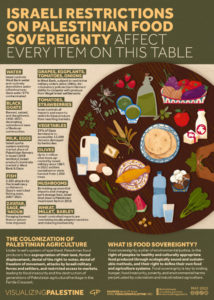As apartheid Israel’s brutal siege of Gaza enters its 15th year this June, food sovereignty and climate activists Mohammed AbuJayyab and Asmaa Abu Mezied emphasized the centrality of the agricultural space in building resistance, autonomy and community in the greater fight for justice and Palestinian liberation in a recent public conversation hosted by Adalah Justice Project (AJP) and American Friends Service Committee (AFSC).
“To talk about agriculture in Gaza particularly, the first thing that comes to mind is the systematic challenges that face farmers in Gaza,” related to climate change and daily worries of production, yield and market prices, says Abu Mezeid, an economic development and social inclusion specialist .“Diving deep into them, you will understand how political and politicized these challenges are.”
Organizing around climate justice, agriculture, and self-sufficiency is often depoliticized and, in Gaza in particular, is poorly understood and relegated to the humanitarian food security scene. And whereas discussions of food security have largely turned to a mathematical science focusing purely on numbers – such as how many calories people have access to, nutrient content of available food, etc. – food sovereignty offers a more holistic and transformational approach.
AbuJayyab, a Palestinian fellah, farmer, and food sovereignty activist, describes food sovereignty as a process of “self discovery” that goes beyond the bare-bones framework of food security. “Food sovereignty is really about the choice in the production and consumption cycle of food, of foods that happen to be relevant ecologically, culturally and economically,” continued AbuJayyab.
Currently in Gaza, cash crops such as strawberries and flowers are king due to a necessity for income within a convoluted trade system subject to change at Israel’s whims, as well as a lack of available land for more sustainable food crops. This dependency on cash crops, however, has resulted in an increased reliance on importing food products used in daily life – imports which are also subject to fluctuations from Israel.
How radically different were crops in pre-1948 Palestine when compared to Palestine today? “Just a single field crop (wheat) was five times bigger than the amount of land that is available for people in Gaza Strip,” says AbuJayyab.
Israel also suppresses the work of cooperatives, critical spaces for food sovereignty and Palestinian liberation, through barriers imposed on the trading and selling of goods outside of Gaza. Abu Mezeid shared the example of the tomato. “Lots of agricultural farmers plant tomatoes to be traded with the West Bank or other places. Now the Israelis put restrictions on the selling of tomatoes that you have to remove the (stem). That reduces the shelf life of the tomato by half. And if you have those tomatoes staying at the crossing for a couple of days, then you will have huge losses.”
The extent of crop destruction and degradation carried out under Israel’s Zionist project is only further exacerbated by the effects of the ongoing siege of Gaza, which has been deemed illegal under international law. “The Gaza Strip is a very small geographic area. The total area of the Gaza Strip is 140 square miles, equivalent to the total area of metropolitan Detroit. But imagine metropolitan Detroit as an area that is isolated from its surroundings so there is no access to further land beyond the confines of this blockaded (area),” stated Jehad Abusalim, Education and Policy Associate at the American Friends Service Committee.
AbuJayyab also points out the extremely unequal population distribution within the area, particularly in refugee camps. Access to parcels of land and resources between refugee camp areas and the rest or between the north and south of Gaza can vary widely, fostering discord – an intentional outcome of the Israeli occupation. NGOs working on food security and agriculture in Gaza frequently intensify this social stratification by focusing on more arable and developed areas in the north that are easier to make sustainable, therefore widening the gap.
Abu Mezeid and AbuJayyab both also point out the complicity of aid organizations in maintaining the status quo through their unwillingness to recognize the political roots of the ongoing economic, humanitarian and ecological crisis in Gaza and Palestine more broadly.

